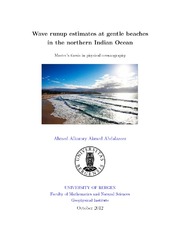Wave runup estimates at gentle beaches in the northern Indian Ocean
Master thesis
Permanent lenke
https://hdl.handle.net/1956/7159Utgivelsesdato
2012-10-01Metadata
Vis full innførselSamlinger
- Geophysical Institute [1198]
Sammendrag
The aim of this study is to estimate the wave runup on selected beaches around the northern Indian Ocean. The runup has been estimated using ERA-Interim, which is the latest global atmospheric re-analysis produced by the European Centre for Medium-Range Weather Forecasts (ECMWF). ECMWF uses the global Wave Model (WAM) model to calculate two dimensional wave spectra. The distances between the model grid points and the beaches have been calculated by a great circle calculator. The beach slopes have been calculated by Google Earth for all locations, except Maldives beach, which was assumed as an imaginary beach because the method of calculating the slope could not be used there. The significant wave height as well as the peak wave period at the grid points are assumed to be the same at the beach. The most frequent estimated runup is between 0.5 m and 1.0 m, which is produced by swell coming from the southern Indian Ocean for all locations except Sri Lanka, India and Maldives shores, where the most frequent runup value is less than 0.5 m. However, the extreme wave runup occurs with the largest wave heights during summer monsoon in July. Generally, the high wave height depends on wind sea. The mean elevation of the runup for all locations is 0.56 m. It is comparable to the measured values obtained by (Stochdon et al., 2006) at several beaches in USA and the Netherlands who found the mean value of dissipative sites (84 cm) for all experiments.
